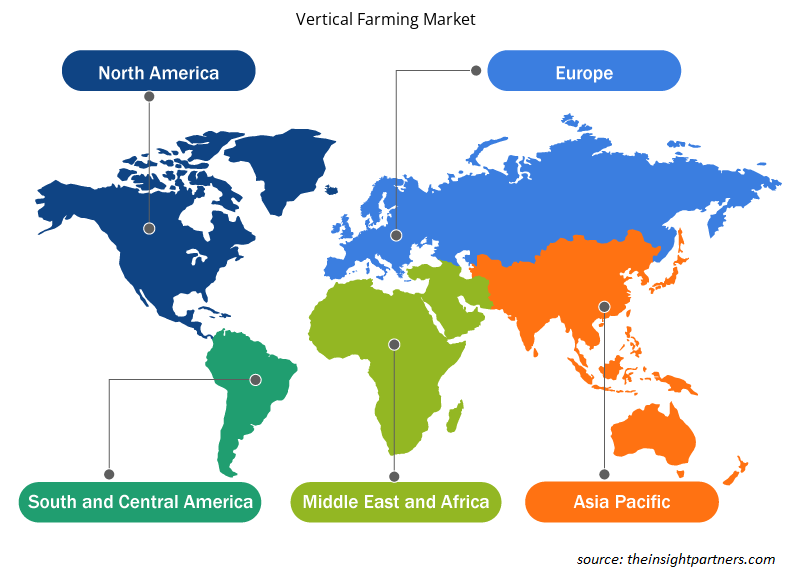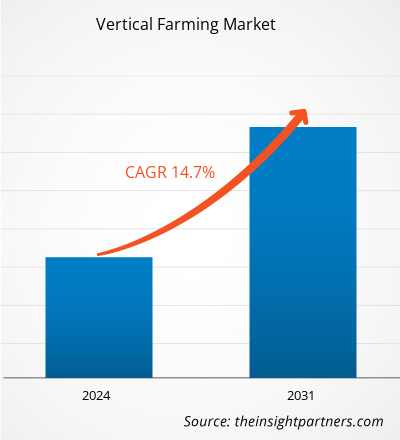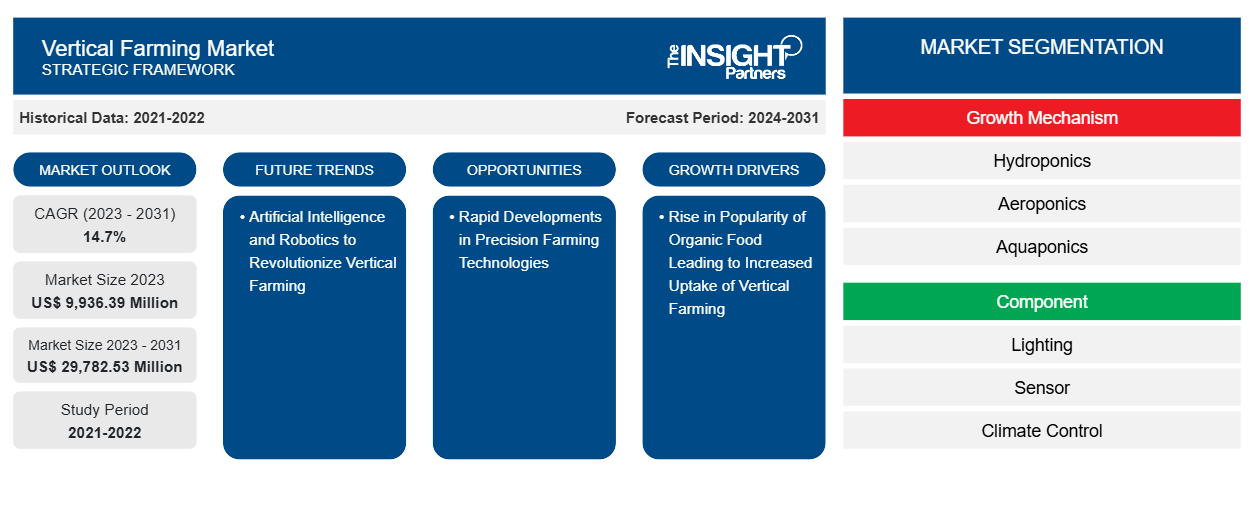Le marché de l'agriculture verticale devrait atteindre 29 782,53 millions USD d'ici 2031, contre 9 936,39 millions USD en 2023. Le marché devrait enregistrer un TCAC de 14,7 % au cours de la période 2023-2031. La demande croissante d'aliments biologiques et l'importance croissante accordée à l'agriculture de précision devraient rester une tendance clé du marché.
Analyse du marché de l'agriculture verticale
La croissance démographique et la sensibilisation des consommateurs à une alimentation saine sont des facteurs majeurs de l’agriculture verticale. L’intérêt croissant pour l’agriculture intelligente et de précision influence également positivement le marché de l’agriculture verticale à l’échelle mondiale. Le manque de sensibilisation et le coût élevé de la maintenance sont quelques-unes des raisons qui pourraient entraver la croissance du marché. Cependant, les initiatives gouvernementales croissantes en faveur des techniques d’agriculture intelligente devraient stimuler la croissance de l’agriculture verticale au cours de la période de prévision.
Aperçu du marché de l'agriculture verticale
L'agriculture verticale est un processus de culture ou d'empilement vertical de cultures. Le processus complet est réalisé dans des environnements contrôlés en utilisant des méthodes telles que la culture hydroponique, aéroponique et aquaponique . Le processus permet de cultiver des cultures avec une quantité d'eau bien inférieure à celle des techniques agricoles conventionnelles. En outre, l'agriculture verticale réduit également le besoin de pesticides et d'autres pesticides toxiques pour faire pousser des cultures. L'urbanisation croissante et la croissance démographique augmentent les besoins alimentaires, ce qui constitue un moteur pour le marché. Les sociétés pharmaceutiques se concentrent également sur l'agriculture verticale en intérieur pour cultiver des plantes biomédicales destinées aux médicaments, ce qui constitue également l'une des principales tendances positives du marché mondial.
Personnalisez ce rapport en fonction de vos besoins
Vous bénéficierez d'une personnalisation gratuite de n'importe quel rapport, y compris de certaines parties de ce rapport, d'une analyse au niveau des pays, d'un pack de données Excel, ainsi que de superbes offres et réductions pour les start-ups et les universités.
-
Obtenez les principales tendances clés du marché de ce rapport.Cet échantillon GRATUIT comprendra une analyse de données, allant des tendances du marché aux estimations et prévisions.
Moteurs et opportunités du marché de l'agriculture verticale
La popularité croissante des aliments biologiques favorise le marché
La prise de conscience croissante de la santé et l'inclination pour les produits alimentaires sains sont les principaux moteurs du marché de l'agriculture verticale. Les consommateurs préfèrent et manifestent leur intérêt pour la consommation de cultures biologiques telles que les fruits, les légumes et les céréales. La sensibilisation croissante à la santé est l'une des principales raisons de la demande croissante des consommateurs pour des produits alimentaires sans substances artificielles ni produits chimiques nocifs. Les risques sanitaires croissants liés à la consommation de cultures ou de légumes traités chimiquement agissent comme un moteur majeur des aliments biologiques, ce qui stimule la demande d'agriculture verticale. La demande croissante de produits alimentaires non conventionnels et biologiques tout au long de l'année influence également positivement le marché mondial.
L'intelligence artificielle et la robotique pour transformer l'agriculture verticale
Les progrès technologiques croissants en termes d'automatisation des processus et d'intégration de la technologie robotique devraient offrir de grandes opportunités au marché de l'agriculture verticale. Les exploitations agricoles opérant sur le marché se concentrent davantage sur les activités de recherche et développement pour introduire la technologie de l'intelligence artificielle afin de faire progresser l'entretien et les soins des plantes de manière plus organisée et rationalisée. En outre, certaines entreprises se concentrent également sur l'introduction de robots dans le secteur de l'agriculture verticale afin de réduire l'intervention humaine et d'augmenter l'efficacité du temps, ce qui devrait également stimuler la croissance du marché de l'agriculture verticale à l'échelle mondiale.
Analyse de segmentation du rapport sur le marché de l'agriculture verticale
Les segments clés qui ont contribué à l’élaboration de l’analyse du marché de l’agriculture verticale sont les mécanismes et les composants de croissance des produits.
- En fonction du mécanisme de croissance, le marché est divisé en hydroponie, aéroponie et aquaponie. Le segment hydroponique détenait une part de marché plus importante en 2023.
- Par composant, le marché est segmenté en éclairage, capteurs, climatisation, composants d'irrigation, matériaux de construction et autres. Le segment de l'éclairage détenait une part importante du marché en 2023.
Analyse des parts de marché de l'agriculture verticale par zone géographique
La portée géographique du rapport sur le marché de l’agriculture verticale est principalement divisée en cinq régions : Amérique du Nord, Asie-Pacifique, Europe, Moyen-Orient et Afrique, et Amérique du Sud et centrale.
L'Amérique du Nord est en tête du marché. Les investissements élevés dans les technologies de pointe pour stimuler la production alimentaire et augmenter la disponibilité des fruits et légumes de saison tout au long de l'année stimulent la demande d'agriculture verticale dans la région de l'Amérique du Nord. La demande croissante de fruits, céréales et légumes non conventionnels et cultivés de manière biologique stimule également l'évolution du marché en Amérique du Nord. Les variations de température et les conditions météorologiques changeantes sont des facteurs majeurs qui entravent la croissance des légumes et des fruits dans divers pays. Les pays aux conditions de température extrêmes alimentent la demande d'agriculture verticale en Amérique du Nord. La contrainte d'espace est également satisfaite par l'agriculture en couches superposées, qui est l'une des principales raisons de l'adoption croissante des techniques d'agriculture verticale. L'adoption croissante de l'automatisation et l'augmentation de la technologie robotique dans le secteur agricole ont également une influence positive sur le marché de l'agriculture verticale dans la région. Les États-Unis sont en tête du marché de l'agriculture verticale en Amérique du Nord.
Aperçu régional du marché de l'agriculture verticale
Les tendances et facteurs régionaux influençant le marché de l’agriculture verticale tout au long de la période de prévision ont été expliqués en détail par les analystes d’Insight Partners. Cette section traite également des segments et de la géographie du marché de l’agriculture verticale en Amérique du Nord, en Europe, en Asie-Pacifique, au Moyen-Orient et en Afrique, ainsi qu’en Amérique du Sud et en Amérique centrale.

- Obtenez les données régionales spécifiques au marché de l'agriculture verticale
Portée du rapport sur le marché de l'agriculture verticale
| Attribut de rapport | Détails |
|---|---|
| Taille du marché en 2023 | 9 936,39 millions de dollars américains |
| Taille du marché d'ici 2031 | 29 782,53 millions de dollars américains |
| Taux de croissance annuel composé mondial (2023-2031) | 14,7% |
| Données historiques | 2021-2022 |
| Période de prévision | 2024-2031 |
| Segments couverts |
Par mécanisme de croissance
|
| Régions et pays couverts |
Amérique du Nord
|
| Leaders du marché et profils d'entreprises clés |
|
Densité des acteurs du marché de l'agriculture verticale : comprendre son impact sur la dynamique commerciale
Le marché de l'agriculture verticale connaît une croissance rapide, tirée par la demande croissante des utilisateurs finaux en raison de facteurs tels que l'évolution des préférences des consommateurs, les avancées technologiques et une plus grande sensibilisation aux avantages du produit. À mesure que la demande augmente, les entreprises élargissent leurs offres, innovent pour répondre aux besoins des consommateurs et capitalisent sur les tendances émergentes, ce qui alimente davantage la croissance du marché.
La densité des acteurs du marché fait référence à la répartition des entreprises ou des sociétés opérant sur un marché ou un secteur particulier. Elle indique le nombre de concurrents (acteurs du marché) présents sur un marché donné par rapport à sa taille ou à sa valeur marchande totale.
Les principales entreprises opérant sur le marché de l'agriculture verticale sont :
- Technologie verte Eden
- Fermes Elevate Inc.
- iFarm
- OSRAM GmbH
- Plenty Unlimited Inc.
- Verts du ciel
Avis de non-responsabilité : les sociétés répertoriées ci-dessus ne sont pas classées dans un ordre particulier.

- Obtenez un aperçu des principaux acteurs du marché de l'agriculture verticale
Actualités et développements récents du marché de l'agriculture verticale
Le marché de l'agriculture verticale est évalué en collectant des données qualitatives et quantitatives après des recherches primaires et secondaires, qui comprennent d'importantes publications d'entreprise, des données d'association et des bases de données. Quelques-uns des développements du marché de l'agriculture verticale sont répertoriés ci-dessous :
- Eden Green Technology a obtenu 12 millions de dollars pour sa combinaison ferme-serre verticale. (Source : Eden Green Technology, communiqué de presse, mars 2024)
- Elevate Farms Inc. a annoncé l'expansion de sa production de légumes verts à feuilles cultivés verticalement aux États-Unis et en Europe. (Source : Elevate Farms Inc., communiqué de presse, février 2024)
Rapport sur le marché de l'agriculture verticale : couverture et livrables
Le rapport « Taille et prévisions du marché de l’agriculture verticale (2021-2031) » fournit une analyse détaillée du marché couvrant les domaines ci-dessous :
- Taille et prévisions du marché de l'agriculture verticale aux niveaux mondial, régional et national pour tous les segments de marché clés couverts par le périmètre
- Tendances du marché de l'agriculture verticale ainsi que dynamique du marché telles que les moteurs, les contraintes et les opportunités clés
- Analyse PEST et SWOT détaillée
- Analyse du marché de l'agriculture verticale couvrant les principales tendances du marché, le cadre mondial et régional, les principaux acteurs, les réglementations et les développements récents du marché
- Analyse du paysage industriel et de la concurrence couvrant la concentration du marché, l'analyse de la carte thermique, les principaux acteurs et les développements récents du marché de l'agriculture verticale
- Profils d'entreprise détaillés
- Analyse historique (2 ans), année de base, prévision (7 ans) avec TCAC
- Analyse PEST et SWOT
- Taille du marché Valeur / Volume - Mondial, Régional, Pays
- Industrie et paysage concurrentiel
- Ensemble de données Excel
Rapports récents
Témoignages
Raison d'acheter
- Prise de décision éclairée
- Compréhension de la dynamique du marché
- Analyse concurrentielle
- Connaissances clients
- Prévisions de marché
- Atténuation des risques
- Planification stratégique
- Justification des investissements
- Identification des marchés émergents
- Amélioration des stratégies marketing
- Amélioration de l'efficacité opérationnelle
- Alignement sur les tendances réglementaires























 Obtenez un échantillon gratuit pour - Marché agricole vertical
Obtenez un échantillon gratuit pour - Marché agricole vertical